Fielding Alignments
INFIELD ALIGNMENTS
Definition
Every infield defense alignment will fall into one of the following four categories:
- Standard: All four infielders are positioned in a basic/typical/traditional spot on the field
- Shift: Three or more infielders on the same side of second base (only applies to pre-2023)
- Shaded: At least one fielder is positioned outside the area of the field they're typically responsible for. (Example: The SS is "shaded" when playing up the middle against a LHB or toward the 3B zone against a RHB)
- Strategic: Any other tactical alignment. (Examples: an infielder playing in or holding the line, an outfield rover, a fifth infielder, etc.)
A variety of fielder positioning leaderboards are viewable here at Baseball Savant.
1) Standard
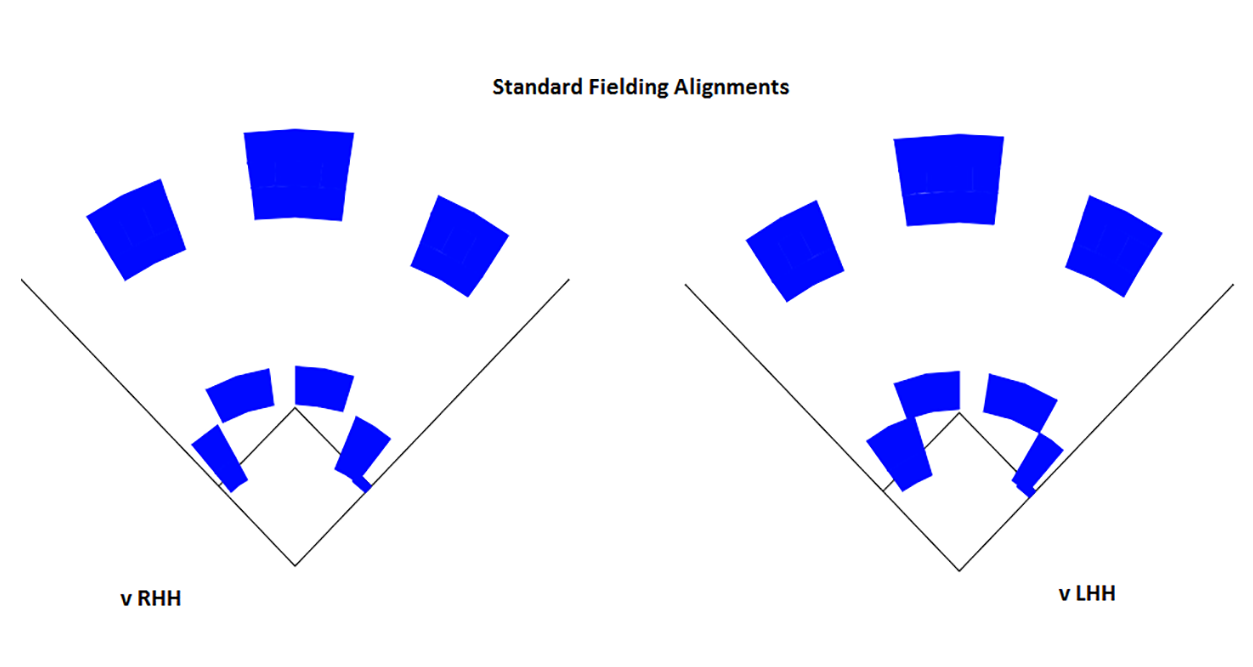
In order to know when a fielder is shifted, you need to know where they’re shifting from in the first place. The "standard" alignment is when all four infielders are positioned in their traditional spots (pictured above).
In 2017, 78% of all pitches came with fielders in the "standard" positions. By 2022, the final season before shifts were restricted by MLB, only 56% of pitches league-wide were under a standard infield alignment.
Standard positions are defined based on the zones where, under neutral conditions (first to eighth inning, no runners on), the league average fielder was positioned 70% to 90% of the time:
vs. LHH
- 1B: Between 85-130 feet from home; angle between 31 and 42 degrees
- 2B: Between 130-160 feet from home; angle between 9 and 31 degrees
- SS: Between 130-160 feet from home; angle between -18 and 0 degrees
- 3B: Between 80-130 feet from home; angle between -37 and -17 degrees
vs. RHH
- 1B: Between 85-130 feet from home; angle between 23 and 38 degrees
- 2B: Between 130-160 feet from home; angle between 0 and 18 degrees
- SS: Between 130-160 feet from home; angle between -8 and -28 degrees
- 3B: Between 80-130 feet from home; angle between -42 and -30 degrees
For angles above: -45 degrees is the third-base line, 0 degrees is straight up the middle from home plate to center field, and +45 degrees is the first-base line.
2) Shift
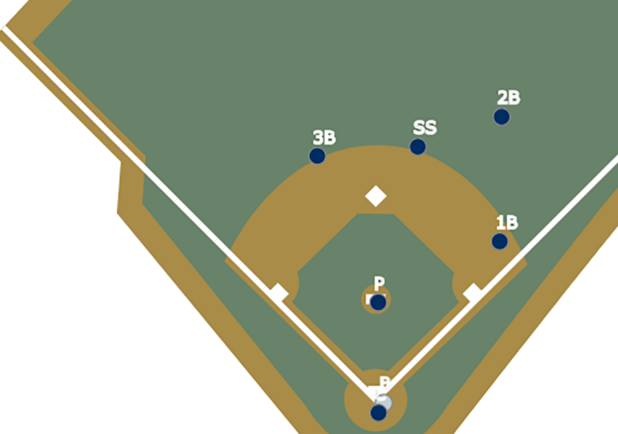
A shift is a term used to describe the situational defensive realignment of fielders away from their "traditional" starting points. Infield shifts and outfield shifts are tracked separately.
An infield shift is when three infielders (or more, in some cases) are positioned to the same side of second base. This is the most common type of shift.
In 2023, MLB implemented rules changes limiting the use of infield shifts. Under the new rules, defensive teams are required to have a minimum of four players on the infield, with at least two infielders completely on either side of second base. A full "shift" -- three infielders on one side of second base -- is no longer allowed.
Year-by-year MLB shift data is available here.
In the 2022 season, for example, MLB teams deployed an infield shift on 38% of total plate appearances league-wide. Left-handed hitters were shifted against on 62% of their plate appearances, while right-handed hitters were shifted against on 22% of their plate appearances.
3) Shaded
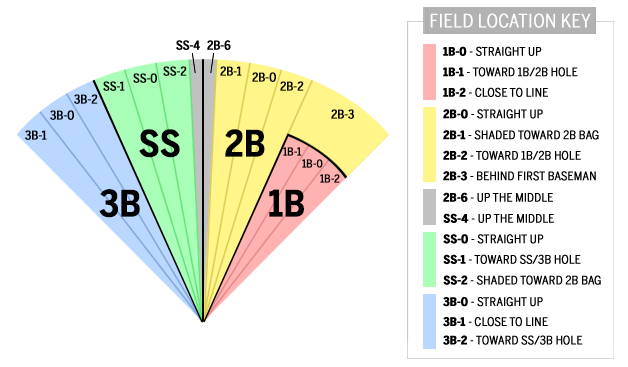
An infielder is "shaded" when he's stationed outside the typical "slice" of the field for his position, but not fully shifted -- in other words, he's still within the infield, and not on the opposite side of second base. Typically that means he's positioned to the left or right of where he would normally play.
For example, a shortstop would be shaded when playing up the middle against a left-handed hitter, or in the hole toward third base against a right-handed hitter. Similarly, a second baseman would be shaded if he plays up the middle against a right-handed hitter, but still on his own side of the bag.
In the image above, a shortstop would be "shaded" if he's playing in zone SS-4, or in any of the 3B slices. A second baseman would be "shaded" if he's playing in zone 2B-6.
For the 2023 season, with full shifts no longer allowed, teams shaded their infielders for 22% of plate appearances -- 44% of plate appearances vs. left-handed hitters and 7% of plate appearances vs. right-handed hitters.
4) Strategic infield alignment
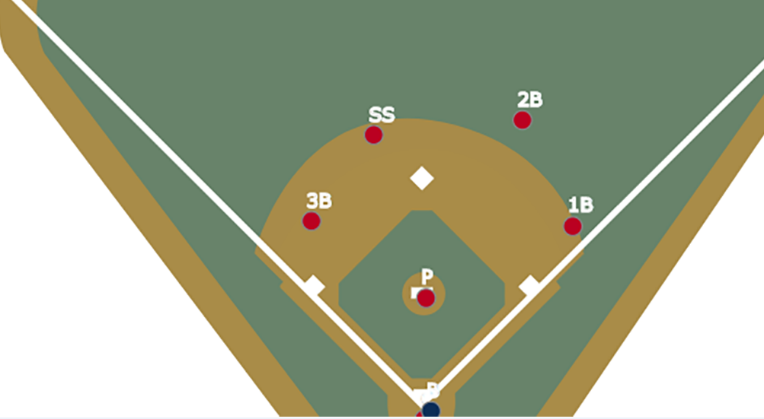
A "strategic" defensive alignment is a catch-all term for a team using positioning that is neither standard, nor a full shift.
Strategies that fall under the strategic category include playing the infield in, guarding the lines, using five infielders, or using an outfield rover.
There is often just a single player being out of position, like a second baseman playing in short right field while no other infielders are outside their typical zone (as in the image above).
For the 2022 season, teams used strategic infield alignments for 6% of plate appearances league-wide. In 2023, that number increased to over 8% of plate appearances.
Here are some video examples of strategic infield alignments in use:
- Mets second baseman Jeff McNeil as a "rover" in short right field
- The Brewers bring the infield in and get the out at home
- The Marlins successfully use a 5-man infield vs. Paul Goldschmidt
OUTFIELD POSITIONING
DEFINITION
Statcast currently groups outfield positioning into one of four categories:
- Standard
- 3 OF to one side of 2B
- 4th Outfielder
- Strategic
1) Standard
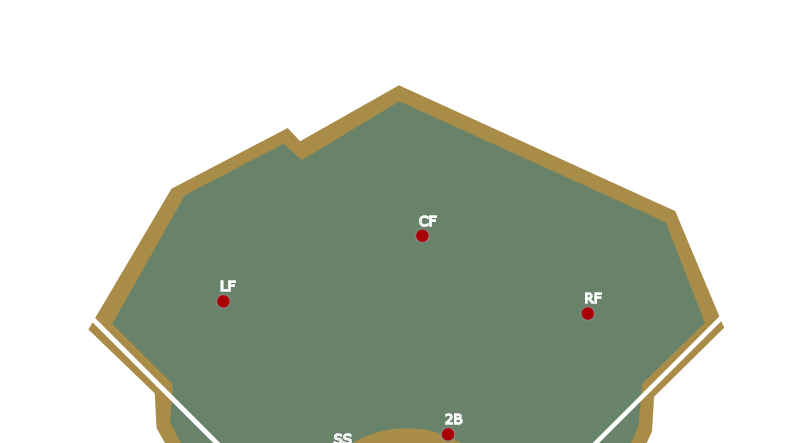
For outfield defense, a "standard" alignment is when all three outfielders are standing in their traditional spots: left field, center field and right field.
The standard outfield positions are defined based on the zones where, under neutral conditions (first to eighth inning, no runners on), the league average fielder was positioned 70% to 90% of the time.
- LF: Between 260-320 feet from home; angle between -33 and -21 degrees
- CF: Between 280-350 feet from home; angle between -8 and 7 degrees
- RF: Between 260-320 feet from home; angle between 21 and 33 degrees
For angles above: -45 degrees is the third-base line, 0 degrees is straight up the middle from home plate to center field, and +45 degrees is the first-base line.
2) 3 OF to one side of 2B
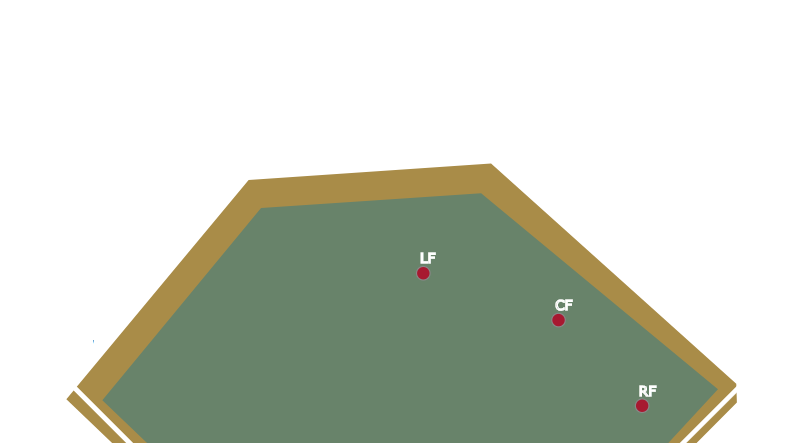
This alignment is exactly what it sounds like: Three outfielders are positioned on the same side of second base (the equivalent of a full infield shift, but with the outfielders).
It is a rare alignment. In 2017, for example, this was only seen by the D-Backs against the Rockies' DJ LeMahieu, an extreme opposite-field hitter.
3) 4th Outfielder
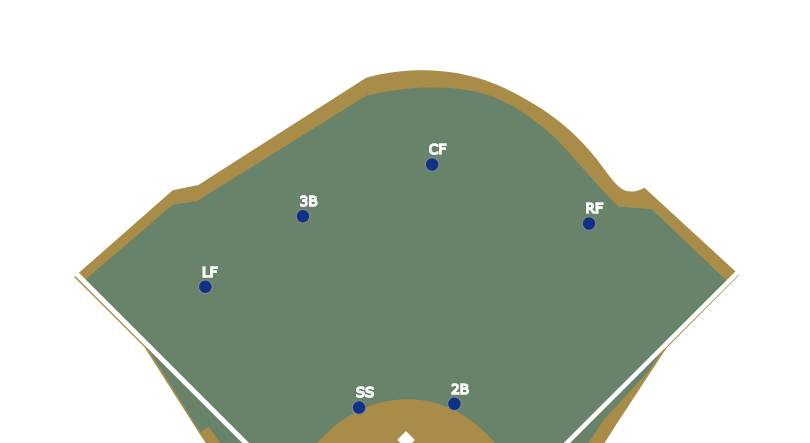
A four-man outfield is a defensive alignment that teams have used against extreme fly-ball hitters. In this alignment, they will move one of their infielders deep into the outfield to serve as the fourth outfielder.
The question of "When is an infielder playing far enough out to be considered an outfielder" is complicated. Statcast currently considers the dividing line between "infielder" and "outfielder" to be 220 feet from home plate. (Read more on that here.) When an infielder is playing deeper than that line, Statcast considers him to be a fourth outfielder.
This is also a relatively rare alignment, most notably seen against hitters like Joey Votto (seen here in 2017) and Joey Gallo (seen here in 2018). The Blue Jays notably used a four-man outfield frequently during the 2022 season.
4) Strategic outfield alignment
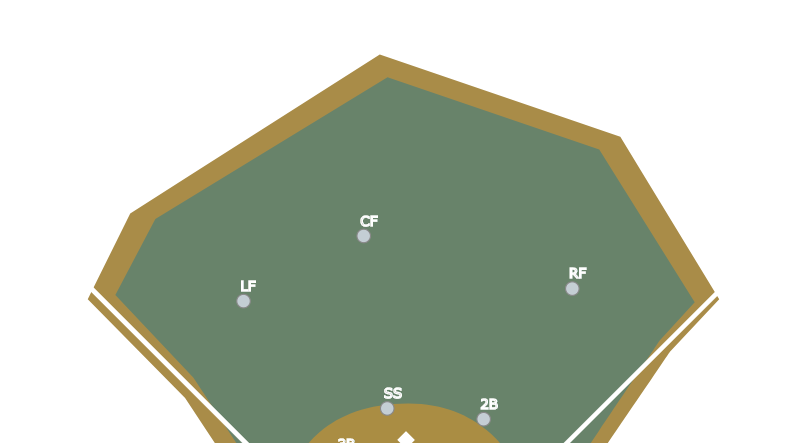
As with infield positioning, a team can set up its outfield in a "strategic" alignment. This occurs when the outfielders are in a non-standard alignment that does not fall into another category.
A strategic outfield alignment might be used against a hitter with predictable fly-ball tendencies -- a player who frequently pulls the ball, or hits to the opposite field. In the image shown above, for example, the center fielder is clearly shaded toward left field, outside his traditional spot. A team might also be playing its outfielders deep, or shallow, depending on the game situation and batter.
During the 2019 season, MLB teams used a strategic outfield alignment on close to 10% of plate appearances, the highest for a season under Statcast tracking. By 2022 and '23, the number of strategic outfield alignments had fallen to under 5% of plate appearances.
Here are a few video examples of strategic outfield alignments: